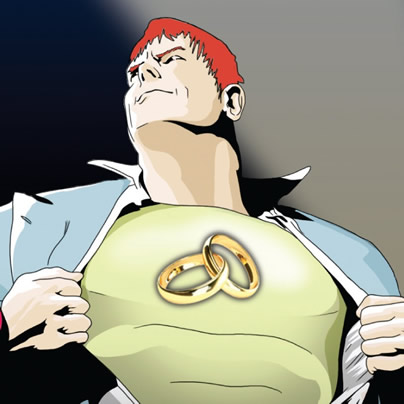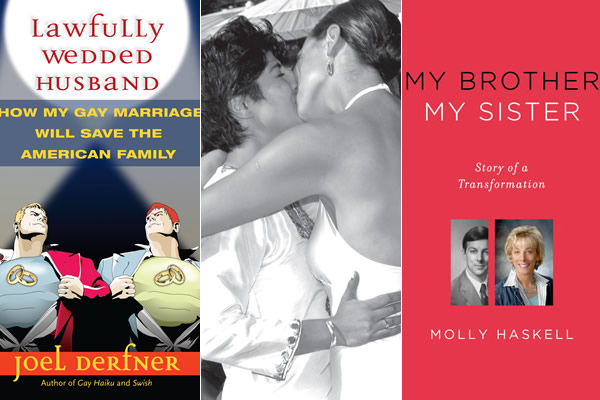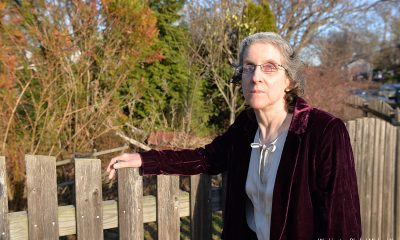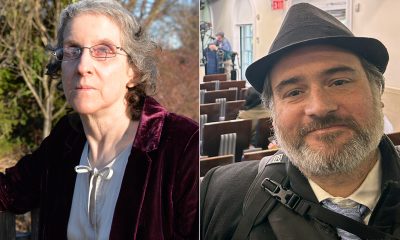Books
Books of the season
Fall peppered with bounty of LGBT releases


Several great books with LGBT themes are out this year. (Photos courtesy of the publishers)
So you’re dreaming, maybe, of a wedding coming up. Maybe it’s yours, or you can live vicariously through the pages of several great books on gay marriage that are out this year.
“Lawfully Wedded Husband” by Joel Derefner (University of Wisconsin Press) is a rompishly fun book about wooing and cooing, chapel bells, wedded bliss and all that comes with it — and more, including a reality show.
Didn’t I say it was fun?
And then there’s “Lawfully Wedded Wives,” edited by Nona Caspers and Joell Hallowell (Spuyten Duyvil, spuytenduyvil.net). In this book, you’ll read a series of vignette-interviews from lesbians who fell in love and took the plunge. This book is huge and lush with page after page of dual tales, each speaking to the romantic and the practical-minded, both. Each story is also filled with love and happiness — and if you need some great ideas for your own wedding, check out the beautiful pictures that accompany each chapter.
Local lesbian poet Kathi Wolfe has a new collection out called “The Green Light” from Finishing Line Press. She’ll read selections at Busboys & Poets (2021 14th Street, N.W.) on Sunday from 5-7 p.m. (bosboysandpoets.com) and at the Nora School (955 Sligo Ave. in Silver Spring, Md.) on Thursday. Details at nora-school.org.
Coming out to your family may have been easy, or it may have been difficult. In “My Brother My Sister” by film critic Molly Haskell (Viking), the author tells the story of her brother who reveals his long-time angst: he’s a woman trapped in a man’s body and at 60-something, he decides to make things right by going through the process to become the woman he knows he’s always been. This is a book about trans history and transsexuals in Western culture, but that’s not all. There’s grief and confusion, dealing with memories and plenty of open-hearted learning; and a story about coming to accept the people you love, all told from the point of view of a family member who watches this transformation.
Who can resist a good scare? Not you, especially when the nights get longer and darker, so you’ll want to look for “This House is Haunted” by John Boyne (Other Press), which will be out just in time for Halloween.
Boyne, author of my absolute all-time favorite books (“The Absolutist”) goes classic here with a proper British nanny who’s hired to tend two children living in a large (and remote!) estate. The kids are creepy, there are no adults around and there’s something watching her — or, at least, there’s something very malevolent lurking around.
Knowing what it is will require some sleuthing — some “don’t-open-that-door” kind of sleuthing, which means you shouldn’t read this book alone. Or in the dark. Or on a stormy night.
Sometimes, all you want is comfort reading (kind of like literary comfort food, if you will) and for that, reach back to “When Women Were Warriors – Book 1: The Warrior’s Path” by Catherine M. Wilson, as read by Janis Ian (Dog Ear Audio). This is the story of a young woman who follows in the footsteps of her mother, her mother’s mother and many of the women in her family who’ve gone to war. The girl, Tamras, begins by becoming a warrior’s apprentice.
Legend has it that Janis Ian loved this book. When Wilson found out, she met Ian and the rest is herstory. “When Women Were Warriors” was released in 2008, but this fresh audio take on the ages-old story of warfare and wisdom will surely come as a welcome fall surprise for brand-new fans of this series.
So go ahead and admit it: you’re positively gleeful on “Glee” nights. And that’s why you’ll want to look for “Drama High” by Michael Sokolove (Riverhead Books). This is the story of a real-life high school theater company and their teacher, Lou Volpe; his life, his 40 years of teaching and the thousands of kids he’s directed in plays that arguably rival that of Broadway. Going further, Sokolove — one of Volpe’s former students — follows a small group of high school actors through one year on the stage and behind the scenes.
And finally, if you’re looking for a gift for yourself or if you really want to impress someone, then look for something a little different from the publishing house of Bruno Gmunder.
The classic photography of David Vance is profiled in “Men and Gods,” due out in November, and it will surely give you some religion. Or if you’re looking for something with a little more action, look for “Tie Me Up! The Complete Guide to Bondage” by Stephan Niederwieser, which also includes how-tos, suggestions for tools to use and a guide for putting aside your inhibitions. And “Beards: An Unshaved History” by Kevin Clarke offers a history of facial hair from the gay perspective, and shows how hot a beard can make a man.
Another interesting coffee table book is the lavishly illustrated “2013 Best of Gay Erotic Art: Capolavoro di Uomo: Masterpiece of Man.” It’s $69.95 and available at capolavoroart.com.
.
Books
New book offers observations on race, beauty, love
‘How to Live Free in a Dangerous World’ is a journey of discovery

‘How to Live Free in a Dangerous World: A Decolonial Memoir’
By Shayla Lawson
c.2024, Tiny Reparations Books
$29/320 pages
Do you really need three pairs of shoes?
The answer is probably yes: you can’t dance in hikers, you can’t shop in stilettos, you can’t hike in clogs. So what else do you overpack on this long-awaited trip? Extra shorts, extra tees, you can’t have enough things to wear. And in the new book “How to Live Free in a Dangerous World” by Shayla Lawson, you’ll need to bring your curiosity.

Minneapolis has always been one of their favorite cities, perhaps because Shayla Lawson was at one of Prince’s first concerts. They weren’t born yet; they were there in their mother’s womb and it was the first of many concerts.
In all their travels, Lawson has noticed that “being a Black American” has its benefits. People in other countries seem to hold Black Americans in higher esteem than do people in America. Still, there’s racism – for instance, their husband’s family celebrates Christmas in blackface.
Yes, Lawson was married to a Dutch man they met in Harlem. “Not Haarlem,” Lawson is quick to point out, and after the wedding, they became a housewife, learned the language of their husband, and fell in love with his grandmother. Alas, he cheated on them and the marriage didn’t last. He gave them a dog, which loved them more than the man ever did.
They’ve been to Spain, and saw a tagline in which a dark-skinned Earth Mother was created. Said Lawson, “I find it ironic, to be ordained a deity when it’s been a … journey to be treated like a person.”
They’ve fallen in love with “middle-American drag: it’s the glitteriest because our mothers are the prettiest.” They changed their pronouns after a struggle “to define my identity,” pointing out that in many languages, pronouns are “genderless.” They looked upon Frida Kahlo in Mexico, and thought about their own disability. And they wish you a good trip, wherever you’re going.
“No matter where you are,” says Lawson, “may you always be certain who you are. And when you are, get everything you deserve.”
Crack open the front cover of “How to Live Free in a Dangerous World” and you might wonder what the heck you just got yourself into. The first chapter is artsy, painted with watercolors, and difficult to peg. Stick around, though. It gets better.
Past that opening, author Shayna Lawson takes readers on a not-so-little trip, both world-wide and with observant eyes – although it seems, at times, that the former is secondary to that which Lawson sees. Readers won’t mind that so much; the observations on race, beauty, love, the attitudes of others toward America, and finding one’s best life are really what takes the wheel in this memoir anyhow. Reading this book, therefore, is not so much a vacation as it is a journey of discovery and joy.
Just be willing to keep reading, that’s all you need to know to get the most out of this book. Stick around and “How to Live Free in a Dangerous World” is what to pack.
The Blade may receive commissions from qualifying purchases made via this post.
Books
Story of paralysis and survival features queer characters
‘Unswerving: A Novel’ opens your eyes and makes you think

‘Unswerving: A Novel’
By Barbara Ridley
c.2024, University of Wisconsin Press
$19.95 / 227 pages
It happened in a heartbeat.
A split-second, a half a breath, that’s all it took. It was so quick, so sharp-edged that you can almost draw a line between before and after, between then and now. Will anything ever be the same again? Perhaps, but maybe not. As in the new book “Unswerving” by Barbara Ridley, things change, and so might you.

She could remember lines, hypnotizing yellow ones spaced on a road, and her partner, Les, asleep in the seat beside her. It was all so hazy. Everything Tave Greenwich could recall before she woke up in a hospital bed felt like a dream.
It was as though she’d lost a month of her life.
“Life,” if you even wanted to call it that, which she didn’t. Tave’s hands resembled claws bent at the wrist. Before the accident, she was a talented softball catcher but now she could barely get her arms to raise above her shoulders. She could hear her stomach gurgle, but she couldn’t feel it. Paralyzed from the chest down, Tave had to have help with even the most basic care.
She was told that she could learn some skills again, if she worked hard. She was told that she’d leave rehab some day soon. What nobody told her was how Les, Leslie, her partner, girlfriend, love, was doing after the accident.
Physical therapist Beth Farringdon was reminded time and again not to get over-involved with her patients, but she saw something in Tave that she couldn’t ignore. Beth was on the board of directors of a group that sponsored sporting events for disabled athletes; she knew people who could serve as role models for Tave, and she knew that all this could ease Tave’s adjustment into her new life. It was probably not entirely in her job description, but Beth couldn’t stop thinking of ways to help Tave who, at 23, was practically a baby.
She could, for instance, take Tave on outings or help find Les – even though it made Beth’s own girlfriend, Katy, jealous.
So, here’s a little something to know before you start reading “Unswerving”: author Barbara Ridley is a former nurse-practitioner who used to care for patients with spinal cord injuries. That should give readers a comfortable sense of satisfaction, knowing that her experiences give this novel an authenticity that feels right and rings true, no faking.
But that’s not the only appeal of this book: while there are a few minor things that might have readers shaking their heads (HIPAA, anyone?), Ridley’s characters are mostly lifelike and mostly likable. Even the nasties are well done and the mysterious character that’s there-not-there boosts the appeal. Put everyone together, twist a little bit to the left, give them some plotlines that can’t ruined by early guessing, and you’ve got a quick-read novel that you can enjoy and feel good about sharing.
And share you will because this is a book that may also open a few eyes and make readers think. Start “Unswerving” and you’ll (heart) it.
The Blade may receive commissions from qualifying purchases made via this post.
Books
Examining importance of queer places in history of arts and culture
‘Nothing Ever Just Disappears’ shines with grace and lyrical prose

‘Nothing Ever Just Disappears: Seven Hidden Queer Histories’
By Diarmuid Hester
c.2024, Pegasus Books
$29.95/358 pages
Go to your spot.
Where that is comes to mind immediately: a palatial home with soaring windows, or a humble cabin in a glen, a ramshackle treehouse, a window seat, a coffeehouse table, or just a bed with a special blanket. It’s the place where your mind unspools and creativity surges, where you relax, process, and think. It’s the spot where, as in the new book “Nothing Ever Just Disappears” by Diarmuid Hester, you belong.

Clinging “to a spit of land on the south-east coast of England” is Prospect Cottage, where artist and filmmaker Derek Jarman lived until he died of AIDS in 1994. It’s a simple four-room place, but it was important to him. Not long ago, Hester visited Prospect Cottage to “examine the importance of queer places in the history of arts and culture.”
So many “queer spaces” are disappearing. Still, we can talk about those that aren’t.
In his classic book, “Maurice,” writer E.M. Forster imagined the lives of two men who loved one another but could never be together, and their romantic meeting near a second-floor window. The novel, when finished, “proved too radical even for Forster himself.” He didn’t “allow” its publication until after he was dead.
“Patriarchal power,” says Hester, largely controlled who was able to occupy certain spots in London at the turn of the last century. Still, “queer suffragettes” there managed to leave their mark: women like Vera Holme, chauffeur to suffragette leader Emmeline Pankhurst; writer Virginia Woolf; newspaperwoman Edith Craig, and others who “made enormous contributions to the cause.”
Josephine Baker grew up in poverty, learning to dance to keep warm, but she had Paris, the city that “made her into a star.” Artist and “transgender icon” Claude Cahun loved Jersey, the place where she worked to “show just how much gender is masquerade.” Writer James Baldwin felt most at home in a small town in France. B-filmmaker Jack Smith embraced New York – and vice versa. And on a personal journey, Hester mourns his friend, artist Kevin Killian, who lived and died in his beloved San Francisco.
Juxtaposing place and person, “Nothing Ever Just Disappears” features an interesting way of presenting the idea that both are intertwined deeper than it may seem at first glance. The point is made with grace and lyrical prose, in a storyteller’s manner that offers back story and history as author Diarmuid Hester bemoans the loss of “queer spaces.” This is really a lovely, meaningful book – though readers may argue the points made as they pass through the places included here. Landscapes change with history all the time; don’t modern “queer spaces” count?
That’s a fair question to ask, one that could bring these “hidden” histories full-circle: We often preserve important monuments from history. In memorializing the actions of the queer artists who’ve worked for the future, the places that inspired them are worth enshrining, too.
Reading this book may be the most relaxing, soothing thing you’ll do this month. Try “Nothing Ever Just Disappears” because it really hits the spot.
The Blade may receive commissions from qualifying purchases made via this post.
-

 Africa4 days ago
Africa4 days agoCongolese lawmaker introduces anti-homosexuality bill
-

 District of Columbia24 hours ago
District of Columbia24 hours agoReenactment of first gay rights picket at White House draws interest of tourists
-

 World4 days ago
World4 days agoOut in the World: LGBTQ news from Europe and Asia
-

 Arizona1 day ago
Arizona1 day agoAriz. governor vetoes anti-transgender, Ten Commandments bill












